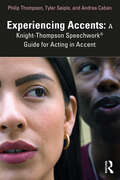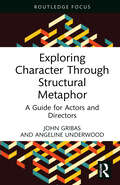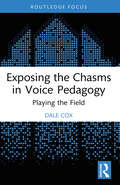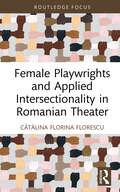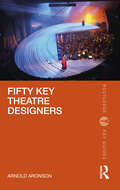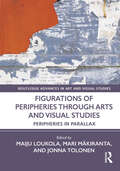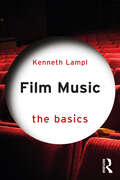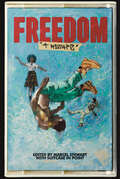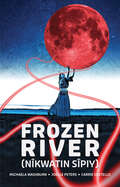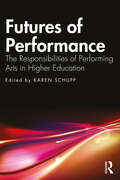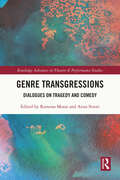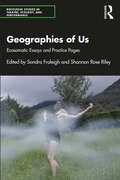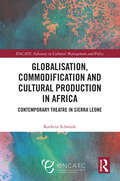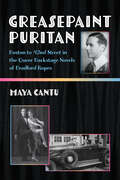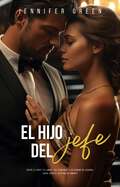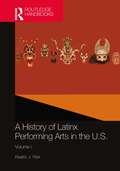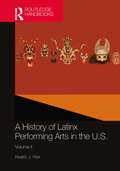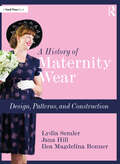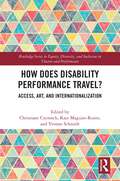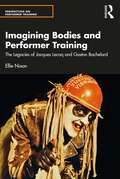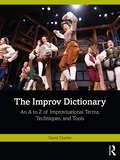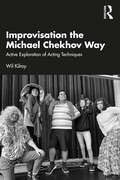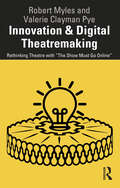- Table View
- List View
Experiencing Accents: A Knight-Thompson Speechwork® Guide for Acting in Accent
by Philip Thompson Tyler Seiple Andrea CabanExperiencing Accents: A Knight-Thompson Speechwork® Guide for Acting in Accent presents a comprehensive and systematic approach to accent acquisition for actors. It lays out an accessible and effective set of tools, exercises, and theoretical frameworks grounded in current linguistic science, as well as more than two decades of teaching, actor training, and coaching developed by Knight-Thompson Speechwork®. This book dismantles the notions that accents exist on a spectrum of good and bad or that "neutral," "general," or "standard" can serve as ideals for speech. By de-centering elitist and authoritarian worldviews, it gives actors a path to mobilize their innate language abilities to acquire any accent, relying on descriptive and experiential knowledge. The innovative approach of the Four Ps – People, Prosody, Posture, and Pronunciation – builds cultural competence that honors accents as they exist in the world, increases the physical and perceptive skills of the actor, and provides a rich variety of applications to encourage fluid and embodied accent performance. Each of the Four Ps are investigated and practiced separately and then synthesized in the art of the performer, allowing actors to address the complexity of acting in accent through a deliberate and sequential layering of skills, rendering the final expression of their technique meticulously accurate and deeply authentic. Organized into fifteen modules to correspond with a typical semester, Experiencing Accents is perfect for Theatre students in voice, speech, and accents courses, along with working actors interested in improving their accent work.
Exploring Character Through Structural Metaphor: A Guide for Actors and Directors (ISSN)
by John Gribas Angeline UnderwoodExploring Character Through Structural Metaphor will help performers discover new and valuable insights into the characters they play. Grounded in a contemporary approach to understanding and applying the power of metaphor, it offers a practical guide for both actors and directors. This book introduces the idea of metaphor as a way of thinking rather than simply as clever comparison or figurative language. It demonstrates limitations of ways metaphor has traditionally been used in character development and presents a method for applying structural metaphor to discover rich, in-depth character insights. For directors, the model can serve as an option for guiding character analysis that is less individualistic and actor-specific and more wholistic and cast-inclusive, promoting stronger overall performance unity and production cohesion. In addition to offering a clear, followable guide for character analysis, the authors draw on personal experience to vividly demonstrate how applying this method for character analysis could impact performance and production. This book will be a useful addition to an actor’s or director’s set of character development resources.
Exposing the Chasms in Voice Pedagogy: Playing the Field
by Dale CoxThis concise book critically examines the intersection of power, privilege, and classical music in higher education through an extensive study of the experiences, training, and background of teachers of musical theatre singing.Mapping the divides within the voice pedagogy field, it shows how despite the growth of non-classical programmes, the teaching of vocal music in the United States continues to be structurally dominated by Western classical music. Drawing on extensive fieldwork and observations of practicing instructors, the author argues that current voice pedagogy training’s classical-centred approach fails to prepare instructors to teach the range of vocal styles needed in the contemporary musical theatre profession. Combining a critical review of existing practices with proposals for change, this book sheds light on a key problem in voice pedagogy today.Based on field research and drawing on both Shulman’s signature pedagogies theory and Bourdieu’s concepts of habitus, capitals, practice, and field, this book will be useful for scholars, researchers, and practitioners of voice pedagogy, higher music education, performance education, cultural studies, music, musical theatre, and theatre studies.
Female Playwrights and Applied Intersectionality in Romanian Theater (Routledge Advances in Theatre & Performance Studies)
by Cătălina Florina FlorescuIn this collection, the author focuses on several contemporary Romanian female playwrights with residencies in Europe and the U.S.: Alexandra Badea, Carmen Francesca Banciu, Alexa Băcanu, Ana Sorina Corneanu, Mihaela Drăgan, Dr. Cătălina Florina Florescu, Dr. Mihaela Michailov, Dr. Domnica Rădulescu, Saviana Stănescu, and Dr. Elise Wilk. In their bold works, written by female playwrights who are academics, activists, and performers, we are invited to discover variations in the modus operandi of the dramatic language itself from metaphorical to matter-of-fact approaches. Furthermore, while all these playwrights speak Romanian, they also think and operate in various other languages, such as Romani, German, French, Italian, and American English. This book facilitates scholars and students to discover contemporary issues related to Romanian society as presented heavily from a feminine angle and to reveal intersectional issues as seen and applied to dramatic characters in a post-communist country from some authors who experienced communism firsthand. The book is also an invitation to reinvent how we teach dramatic literature by offering 20 interactive, exploratory activities.
Fifty Key Theatre Designers (Routledge Key Guides)
by Arnold AronsonFifty Key Theatre Designers looks at the history of theatrical scenography by examining the work and contributions of fifty ground-breaking set, costume, lighting, and projection designers since the Renaissance. Developments of scenic design are traced from the introduction of perspective painting to create illusionistic scenery in Renaissance Italy to the use of digital projection in the twenty-first century. The book also discusses important landmarks in the evolution of costume and lighting design, as well as the introduction of film and video technology to stage design. A broad range of work is explored, including opera, dance, Broadway and West End commercial theatre, avant-garde performance, and even Olympic spectacles. Each chapter features one designer, including basic biographical information and a discussion of that artist’s style, aesthetics, and contributions. Designers covered include Sebastiano Serlio, Ferdinando Bibiena, Richard Wagner, Adolphe Appia, and Edward Gordon Craig, amongst many other notable individuals. Each chapter also includes references to other significant designers with similar aesthetics or who made similarly important contributions to the development of that aspect of scenography. This book is ideal for undergraduates and graduates of scenography, theatrical design, and theatre history.
Figurations of Peripheries Through Arts and Visual Studies: Peripheries in Parallax (Routledge Advances in Art and Visual Studies)
by Maiju Loukola Mari Mäkiranta Jonna TolonenThis edited volume breaks new ground for understanding peripheries and peripherality by providing a multidisciplinary cross-exposure through a collection of chapters and visual essays by researchers and artists. The book is a collection of approaches from several disciplines where the spatial, conceptual, and theoretical hierarchies and biased assumptions of ‘peripheries’ are challenged. Chapters provide a diverse collection of viewpoints, analyses, and provocations on ‘peripherality’ through bringing together international specialists to discuss the socio-political, aesthetic, artistic, ethical, and legal implications of ‘peripheral approach.’ The aim is to illuminate the existing, hidden, often incommensurable, and controversial margins in the society at large from equal, ethical, and empathic perspectives. The book is designed to assist established researchers, academics, and students across disciplines who wish to incorporate novel, arts and practice-based research and critical approaches in their research projects, artwork, and academic writing. Providing both a consolidated understanding of the peripheries, visual studies, and artistic research as they are and setting expansive and new research insights and practices, this book is essential reading for scholars of arts and humanities, visual culture, art history, design, philosophy, and cultural studies.
Film Music: The Basics (The Basics)
by Kenneth LamplA comprehensive introduction to film music, this book provides a concise and illuminating summary of the process of film scoring, as well as a succinct overview of the rich history of contemporary film music. Written in a non-technical style, this book begins by presenting a brief history of film music from the last 30 years, covering topics ranging from blockbuster franchises to indie film scores. It explores film music from around the world, including Bollywood and European Avant-garde cinema, and film music in animation, like Disney-Pixar and Japanese anime. It then offers a guide to the language of film music analysis, the creative process behind composing film music, and the use of current technology. The book champions diversity in the industry, with case studies and interviews from a range of active film composers, including: Pinar Toprak (Captain Marvel, 2019), Kris Bowers (Bridgerton, 2020), Natalie Holt (Loki, 2021), and Rachel Portman (Emma, 1996), Complete with a glossary of key terms and further reading, this book is an invaluable resource for all those beginning to study film music, as well as lifelong film music buffs seeking to update their understanding of film music.
Freedom: A Mixtape
by Marcel Stewart with Suitcase In PointFreedom: A Mixtape is a soulful artistic response to recent and historical violence on Black bodies, presented through a collection of original songs, stories, poems, anecdotes, spoken-word pieces, and musical instrumentation from folks living in Ontario's Niagara Region. A community conversation about our complicated relationship with emancipation and the human right to be free, Freedom: A Mixtape is a compilation album that is part protest and part celebration. It is history and the present moment all at once, a reminder that this moment is part of a larger, ongoing movement. Familiar pains are felt deeply in moments both bygone and bitingly present, setting the tone—and stage—for action.Analog field recordings and soothing talk-radio energy give voice to the residue of intergenerational trauma, the depths of colonialism, resilience amidst oppressive conditions, and a clarion call that joy is a birthright for everyone. With emotional precision and softness, Freedom: A Mixtape offers a radical reminder that in our bleakest moments, we rise up through love of self and community.
Frozen River (nîkwatin sîpiy)
by Michaela Washburn Joelle Peters Carrie CostelloMichaela and Carrie worked together previously on the TYA play Water Under the BridgeAll three authors share the desire to challenge audiences to think about big issues in meaningful ways for young people, wanting to offer something for the next seven generations, as youth are our future
Futures of Performance: The Responsibilities of Performing Arts in Higher Education
by Schupp KarenFutures of Performance inspires both current and future artists/academics to reflect on their roles and responsibilities in igniting future-forward thinking and practices for the performing arts in higher education. The book presents a breadth of new perspectives from the disciplines of music, dance, theatre, and mediated performance and from a range of institutional contexts. Chapters from teachers across various contexts of higher education are organized according to the three main areas of responsibilities of performing arts education: to academia, to society, and to the field as a whole. With the intention of illuminating the intricacy of how performing arts are situated and function in higher education, the book addresses key questions including: How are the performing arts valued in higher education? How are programs addressing equity? What responsibilities do performing arts programs have to stakeholders inside and outside of the academy? What are programs’ ethical obligations to students and how are those met? Futures of Performance examines these questions and offers models that can give us some of the potential answers. This is a crucial and timely resource for anyone in a decision-making position within the university performing arts sector, from administrators, to educators, to those in leadership positions.
Genre Transgressions: Dialogues on Tragedy and Comedy (Routledge Advances in Theatre & Performance Studies)
by Ramona Mosse Anna StreetThis collection gathers a set of provocative essays that sketch innovative and interdisciplinary approaches to Genre Theory in the 21st century. Focusing on the interaction between tragedy and comedy, both renowned and emerging scholarly and creative voices from philosophy, theater, literature, and cultural studies come together to engage in dialogues that reconfigure genre as social, communal, and affective. In revisiting the challenges to aesthetic categorization over the course of the 20th century, this volume proposes a shift away from the prescriptive and hierarchical reading of genre to its crucial function in shaping thought and enabling shared experience and communication. In doing so, the various essays acknowledge the diverse contexts within which genre needs to be thought afresh: media studies, rhetoric, politics, performance, and philosophy.
Genre Transgressions: Dialogues on Tragedy and Comedy (ISSN)
by Ramona Mosse Anna StreetThis collection gathers a set of provocative essays that sketch innovative and interdisciplinary approaches to Genre Theory in the 21st century. Focusing on the interaction between tragedy and comedy, both renowned and emerging scholarly and creative voices from philosophy, theater, literature, and cultural studies come together to engage in dialogues that reconfigure genre as social, communal, and affective.In revisiting the challenges to aesthetic categorization over the course of the 20th century, this volume proposes a shift away from the prescriptive and hierarchical reading of genre to its crucial function in shaping thought and enabling shared experience and communication. In doing so, the various essays acknowledge the diverse contexts within which genre needs to be thought afresh: media studies, rhetoric, politics, performance, and philosophy.
Geographies of Us: Ecosomatic Essays and Practice Pages (Routledge Studies in Theatre, Ecology, and Performance)
by Sondra Fraleigh Shannon Rose RileyGeographies of Us: Ecosomatic Essays and Practice Pages is the first edited collection in the field of ecosomatics.With a combination of essays and practice pages that provide a variety of scholarly, creative, and experience-based approaches for readers, the book brings together both established and emergent scholars and artists from many diverse backgrounds and covers work rooted in a dozen countries. The essays engage an array of crucial methodologies and critical/theoretical perspectives, including practice-based research in the arts, especially in performance and dance studies, critical theory, ecocriticism, Indigenous knowledges, material feminist critique, quantum field theory, and new phenomenologies. Practice pages are shorter chapters that provide readers a chance to engage creatively with the ideas presented across the collection. This book offers a multidisciplinary perspective that brings together work in performance as research, phenomenology, and dance/movement; this is one of its significant contributions to the area of ecosomatics.The book will be of interest to anyone curious about matters of embodiment, ecology, and the environment, especially artists and students of dance, performance, and somatic movement education who want to learn about ecosomatics and environmental activists who want to learn more about integrating creativity, the arts, and movement into their work.
Globalisation, Commodification and Cultural Production in Africa: Contemporary Theatre in Sierra Leone (ENCATC Advances in Cultural Management and Policy)
by Kathrin SchmidtThis book engages with contemporary cultural production in Africa, focusing on theatre in Sierra Leone as main case study. The author provides coverage of, and insights into, such themes as cultural globalisation, commodification, the global creative economy, culture and development, international relations and contemporary cultural production in Sierra Leone within the context of local and global flows of people, media, images, technologies, finance and ideas. Combining the analysis of theatre in Sierra Leone and its aesthetics with its policy, structural and institutional context, this book highlights in much detail and nuance the interconnectedness between the micro- and the macro-levels of cultural production, between the local and the global, and between aesthetics, politics, policy, governance structures and institutions. This book links the particular findings from the author’s fieldwork to larger issues of contemporary local cultural production within the context of globalisation, commodification and decolonisation; adds a postcolonial perspective to existing theories and approaches to cultural production, management and policy, which is still largely missing from the existing discourse; and also contributes to addressing the gap in the knowledge about the context of contemporary cultural productions in diverse African contexts. This book will be particularly useful for both theatre scholars with an interest in the political economy of theatre and, more broadly, those seeking to understand the nuanced challenges and opportunities faced by policymakers, artists and arts managers to embrace the cultural and creative industries in this context. It also offers excellent insights for policymakers who wish to improve their understanding and interventions beyond superficial ‘best practice’ snippets and simplified ‘success stories’.
Greasepaint Puritan: Boston to 42nd Street in the Queer Backstage Novels of Bradford Ropes
by Maya CantuGreasepaint Puritan details the life and work of Bradford Ropes, author of the bawdy 1932 novel 42nd Street, on which the classic film and its stage adaptation are based. Inspired by Ropes’s own experiences as a performer, 42nd Street “reads less like a novel than like a documentary about the lives of New York’s theatre people and, above all, about the practicalities, the personalities, and the sexual politics that go into the making of a show,” according to Richard Brody in The New Yorker. Why did Ropes’s body of work--which included a trilogy of backstage novels--and consequently his biographical footsteps, disappear into obscurity? Descended from Mayflower Pilgrims, Ropes rebelled against the “Proper Bostonian” life, in a career that touched upon the Jazz Age, American vaudeville, and theater censorship. Greasepaint Puritan follows Ropes’s successful career as both a performer and the author of the backstage novels 42nd Street, Stage Mother, and Go Into Your Dance. Populated by scheming stage mothers, precocious stage children, grandiose bit players, and tart-tongued chorines, these novels centered on the lives and relationships of gay men on Broadway during the Jazz Age and Prohibition era. Rigorously researched, Greasepaint Puritan chronicles Ropes’s career as a successful screenwriter in 1930s and ’40s Hollywood, where he continued to be a part of a dynamic gay subculture within the movie industry before returning to obscurity in the 1950s. His legacy lives on in the Hollywood and Broadway incarnations of 42nd Street—but Greasepaint Puritan restores the “forgotten melody” of the man who first envisioned its colorful characters.
El Hijo del Jefe
by Jennifer GreenMadrid 1959. Ignacio Gómez, hijo del Jefe Fernando Gómez, l'omonimo más temido di toda la Capitale, assiema vivido in un costante conflitto con su padre, quieto buscó per todos los medios de mantenerlo alejado de sus turbios negocios. Pero el joven, haremriento de dinero y mujeres hermosas, logró en pocos años, levantar un imperio y superar lentamente el negocio de Fernando. In un attimo della parte della famiglia Álvarez, su padre muere. Ignacio decide vendetta su muerte, accetta la hija, la joven Helena Álvarez, registra conquistando in poco tempo su corazón e haciéndole creer intentará quale sia la cosa più bella. La chica ignora los planes del joven, è innamorata e se di fatto è completamente per i suoi sentimenti hacia él. Pero para Ignacio Gómez, le coste di tutti gli aerei e gli aeroplani che ti obbligano a ceneri e le parole di guerra. Qual è il tuo golpea nel cuore di Ignacio e cambia le carte come è finita qui? Y, ¿si pierde a Helena, significa perderse a sí mismo? Entre el odio y el amor, the venganza y un camino de canang, ¿Cuál será el destino de ambos?
A History of Latinx Performing Arts in the U.S.: Volume I
by Beatriz J. RizkA History of Latinx Performing Arts in the U.S. provides a comprehensive overview of the development of the Latinx performing arts in what is now the U.S. since the sixteenth century. This book combines theories and philosophical thought developed in a wide spectrum of disciplines—such as anthropology, sociology, gender studies, feminism, and linguistics, among others—and productions’ reviews, historical context, and political implications. Split into two volumes, these books offer interpretations and representations of a wide range of Latinxs’ lived experiences in the U.S. Volume I provides a chronological overview of the evolution of the Latinx community within the U.S., spanning from the 1500s to today, with an emphasis on the Chicano artistic renaissance initiated by Luis Valdez and the Teatro Campesino in the 1960s. Volume II continues, looking more in depth at the experiences of Latinx individuals on theatre and performance, including Miguel Piñero, Lin-Manuel Miranda, María Irene Fornés, Nilo Cruz, and John Leguizamo, as well as the important role of transnational migration in Latinx communities and identities across the U.S. A History of Latinx Performing Arts in the U.S. offers an accessible and comprehensive understanding of the field and is ideal for students, researchers, and instructors of theatre studies with an interest in the diverse and complex history of Latinx theatre and performance.
A History of Latinx Performing Arts in the U.S.: Volume II
by Beatriz J. RizkA History of Latinx Performing Arts in the U.S. provides a comprehensive overview of the development of the Latinx performing arts in what is now the U.S. since the sixteenth century. This book combines theories and philosophical thought developed in a wide spectrum of disciplines—such as anthropology, sociology, gender studies, feminism, and linguistics, among others—and productions’ reviews, historical context, and political implications. Split into two volumes, these books offer interpretations and representations of a wide range of Latinxs’ lived experiences in the U.S. Volume I provides a chronological overview of the evolution of the Latinx community within the U.S., spanning from the 1500s to today, with an emphasis on the Chicano artistic renaissance initiated by Luis Valdez and the Teatro Campesino in the 1960s. Volume II continues, looking more in depth at the experiences of Latinx individuals on theatre and performance, including Miguel Piñero, Lin-Manuel Miranda, María Irene Fornés, Nilo Cruz, and John Leguizamo, as well as the important role of transnational migration in Latinx communities and identities across the U.S. A History of Latinx Performing Arts in the U.S. offers an accessible and comprehensive understanding of the field and is ideal for students, researchers, and instructors of theatre studies with an interest in the diverse and complex history of Latinx theatre and performance.
A History of Maternity Wear: Design, Patterns, and Construction
by Lydia Semler Jana Hill Ilea Magdelina BonnerA History of Maternity Wear: Design, Patterns, and Construction explores pregnancy clothing worn throughout the decades, providing historical information, images, and patterns. Filled with photos showing extant attire, with intricate details and sample patterns that can be recreated to scale, this book examines how maternity clothes were constructed, provides historical context, and aids readers in designing their own maternity garments. Each chapter includes examples of commonly worn maternity styles from a number of regions of the English-speaking world, with information from the United States, Britain, Australia, and Canada. The book concludes with a chapter on historically accurate underpinnings from the 17th century to the present day. A History of Maternity Wear: Design, Patterns, and Construction is written for costume professionals looking to research historically accurate characters and costumes for production, as well as fashion historians and costume enthusiasts.
A History of Maternity Wear: Design, Patterns, and Construction
by Lydia Semler Jana Hill Ilea Magdelina BonnerA History of Maternity Wear: Design, Patterns, and Construction explores pregnancy clothing worn throughout the decades, providing historical information, images, and patterns.Filled with photos showing extant attire, with intricate details and sample patterns that can be recreated to scale, this book examines how maternity clothes were constructed, provides historical context, and aids readers in designing their own maternity garments. Each chapter includes examples of commonly worn maternity styles from a number of regions of the English-speaking world, with information from the United States, Britain, Australia, and Canada. The book concludes with a chapter on historically accurate underpinnings from the 17th century to the present day.A History of Maternity Wear: Design, Patterns, and Construction is written for costume professionals looking to research historically accurate characters and costumes for production, as well as fashion historians and costume enthusiasts.
How Does Disability Performance Travel?: Access, Art, and Internationalization (Routledge Series in Equity, Diversity, and Inclusion in Theatre and Performance)
by Christiane Czymoch Kate Maguire-Rosier Yvonne SchmidtThis edited collection investigates the myriad ways in which disability performance travels in a globalized world. Disability arts festivals are growing in different parts of the world; theatre and dance companies with disabled artists are increasingly touring and collaborating with international partners. At the same time, theatre spaces are often not accessible, and the necessity of mobility excludes some disabled artists from being part of an international disability arts community. How does disability performance travel, who does not travel – and why? What is the role of funding and producing structures, disability arts festivals and networks around the world? How do the logics of international (co-)producing govern the way in which disability art is represented internationally? Who is excluded from being part of a touring theatre or dance company, and how can festivals, conferences, and other agents of a growing disability culture create other forms of participation, which are not limited to physical co-presence? This study will contextualize disability aesthetics, arts, media, and culture in a global frame, yet firmly rooted in its smaller national, state, and local community settings and will be of great interest to students and scholars in the field.
Imagining Bodies and Performer Training: The Legacies of Jacques Lecoq and Gaston Bachelard (Perspectives on Performer Training)
by Ellie NixonThis book is a practical and theoretical exploration of the embodied imagining processes of devised performance in which the human and more-than-human are co-implicated in the creative process.This study brings together the work of French theatre pedagogue Jacques Lecoq (1921–1999) and French philosopher of science and the imagination Gaston Bachelard (1884–1962) to explore the notion of the imagination as embodied, enactive and embedded in the devising process. An exploration of compelling correspondences with Bachelard, whose writings imbue Lecoq’s teaching ethos, offers new practical and theoretical perspectives on Lecoq’s ‘poetic body’ in contemporary devising practices. Interweaving first-hand accounts by the author and interviews with contemporary international creative practitioners who have graduated from or have been deeply influenced by Lecoq, Imagining Bodies in Performer Training interrogates how his teachings have been adapted, developed and extended in various cultural, political and historical settings, in Europe, Scandinavia, Asia, and North and South America.These new and rich insights reveal a teaching approach that resists fixity and instead unfolds, develops and adapts to the diverse cultural and political contexts of its practitioners, teachers and students.
The Improv Dictionary: An A to Z of Improvisational Terms, Techniques, and Tools
by David CharlesThe Improv Dictionary: An A to Z of Improvisational Terms, Techniques, and Tools explores improvisational approaches and concepts drawn from a multitude of movements and schools of thought to enhance spontaneous and collaborative creativity.This accessible resource reveals and interrogates the inherited wisdoms contained in the very words we use to describe modern improv. Each detailed definition goes beyond the obvious clichés and seeks a nuanced and inclusive understanding of how art of the moment can be much more than easy laughs and cheap gags (even when it is being delightfully irreverent and wildly funny). This encyclopedic work pulls from a wide array of practitioners and practices, finding tensions and commonalities from styles as diverse as Theatresports, Comedysportz, the Harold, narrative long-form, Playback Theatre, and Boal’s Theatre of the Oppressed. Entries include nuanced definitions, helpful examples, detailed explorations of the concepts in practice, and framing quotes from a leading practitioner or inspirational artistic voice.The Improv Dictionary offers valuable insights to novice improvisers taking their first steps in the craft, seasoned performers seeking to unlock the next level of abandon, instructors craving a new comprehensive resource, and scholars working in one of the numerous allied fields that find enrichment through collaborative and guided play.Each significant entry in the book is also keyed to an accompanying improv game or exercise housed at www.improvdr.com, enabling readers to dig deeper into their process.
Improvisation the Michael Chekhov Way: Active Exploration of Acting Techniques
by Wil KilroyImprovisation the Michael Chekhov Way: Active Exploration of Acting Techniques provides readers with dozens of improvisational exercises based on the acting techniques of Michael Chekhov. The book features key exercises that will help the actor explore improvisation and expand their imagination through the technique. Exercises that have been successfully taught for decades via the intensive trainings from the National Michael Chekhov Association are now clearly laid out in this book, along with information on how these performance-based techniques can be applied to a script and even provide life benefits. Guidance on how to use the exercises both in a group setting and as an individual is provided, as well as tools for lesson plans for up to a year of actor training. These step-by-step exercises will allow readers to expand their range of expression, discover the joy of creating unique characters, improve stage presence and presentation skills, and find new, creative ways to look at life. Improvisation the Michael Chekhov Way is written to be used by individual actors and practitioners and in group settings such as acting or improvisation courses, and to benefit anyone wishing to enhance their creativity and imagination.
Innovation & Digital Theatremaking: Rethinking Theatre with “The Show Must Go Online”
by Robert Myles Valerie Clayman PyeInnovation & Digital Theatremaking introduces a blueprint for how to think differently about Theatre, how to respond creatively in uncertainty, and how to wield whatever resources are available to create new work in new ways. In 2020, the COVID-19 pandemic had a colossal impact on theatre across the world. At a time when even the wealthiest and best-supported theatre companies in the world ceased all operations and shuttered their stages, the theatre company The Show Must Go Online (TSMGO) forged its way into a new frontier: the highly accessible digital landscape of online performance. In this book, TSMGO creator Robert Myles and Valerie Clayman Pye explore the success of TSMGO from a practical standpoint, offering insights and strategies that can help theatremakers at every level respond proactively to the future of Theatre in the digital era. Each chapter addresses a different aspect of the creative process and concludes with take-homes so readers can learn how to innovate rapidly, undertake research and development in order to create their own models, and cultivate their own theatrical communities. Written for theatremakers, directors, producers, and creatives of all levels of experience, this book will help readers to think critically and creatively about theatre and theatre pedagogues to understand how to train their students for the theatre of the future.
